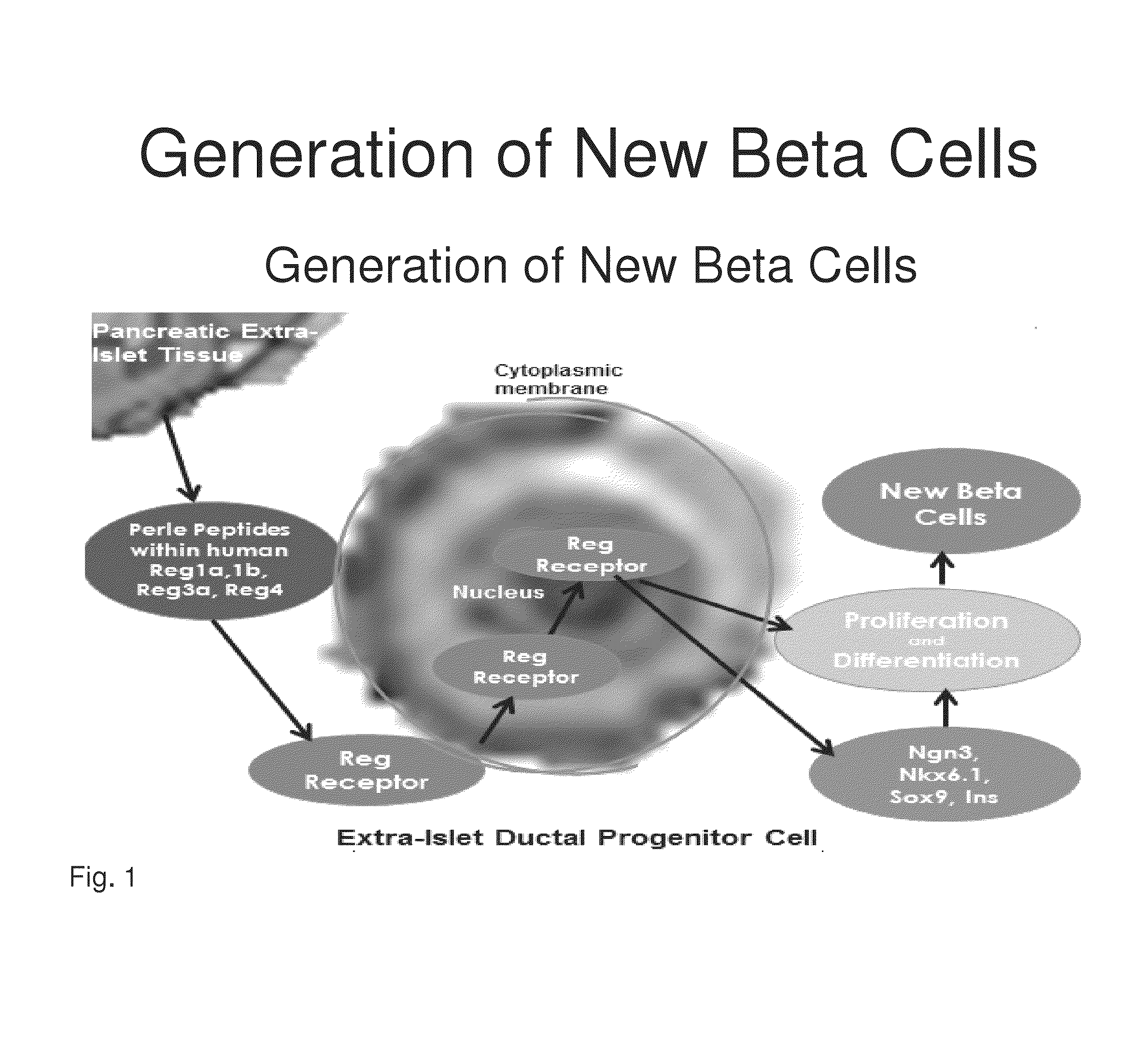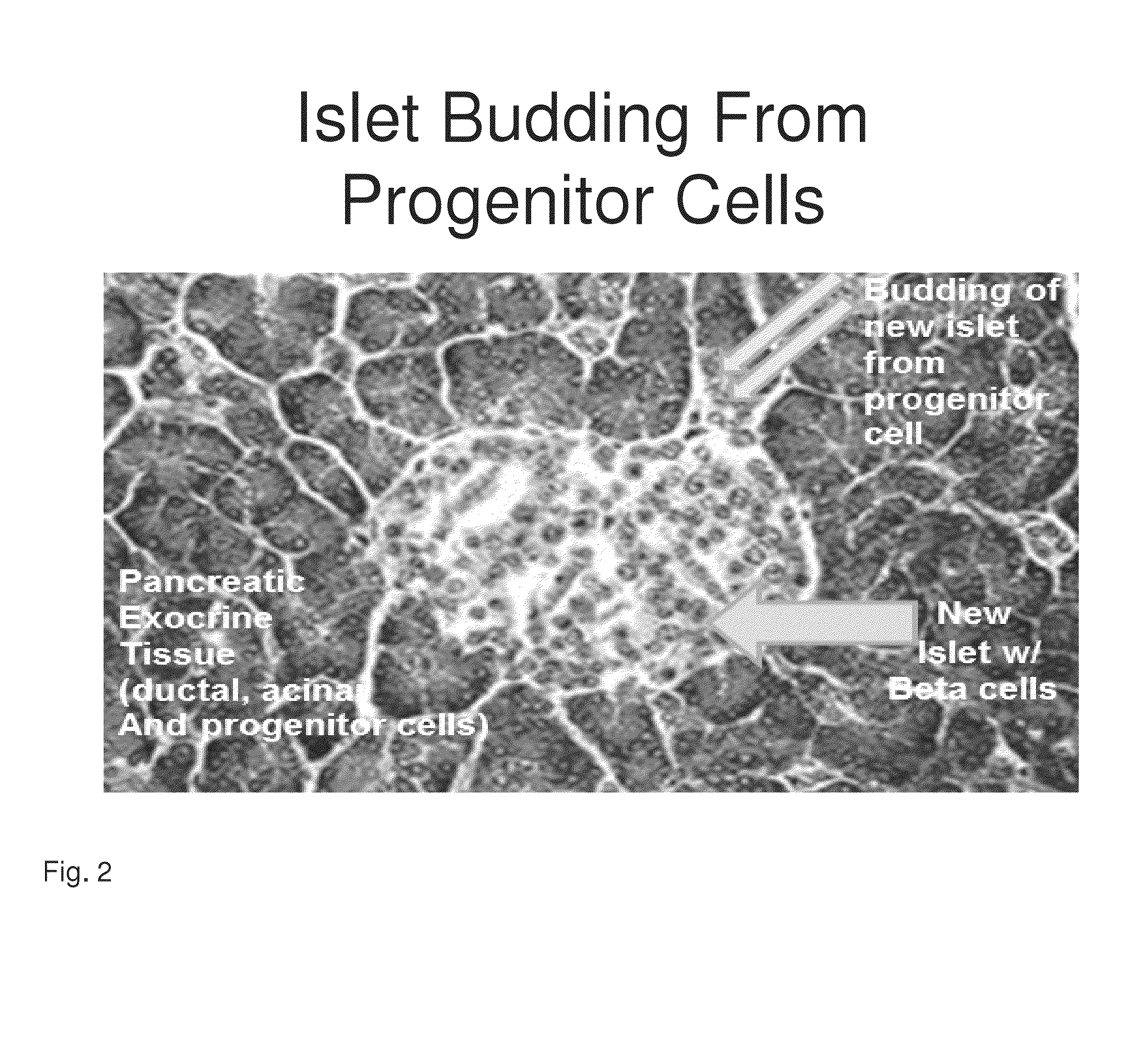Generation of new pancreatic beta cells
a pancreatic beta cell and pancreatic cancer technology, applied in the field of new pancreatic beta cells, can solve the problems of inability to sustain over time among adults, and inability to improve diabetes control or the necessity to go to insulin therapy. , the use of glucose sensors and insulin pumps does not improve hemoglobin a1c levels
- Summary
- Abstract
- Description
- Claims
- Application Information
AI Technical Summary
Benefits of technology
Problems solved by technology
Method used
Image
Examples
example 1
Determining the Binding of Perle Peptides to the Reg Receptor
[0191]Reg peptides have been shown in the prior art to be rate limiting in the development of new beta cells. Based upon the structure and 3-dimensional alignment, folding and properties of the amino acids within the human Reg1a, Reg1b, Reg3a and Reg 4 proteins, common peptide sequences were identified that are present in a right protrusion (circled in FIG. 3). This invention identifies homologous peptide sequences that are not contained within the previously described 14-amino acid human Reg3a peptide (HIP) and a 15-amino acid hamster peptide (INGAP). Investigation was then undertaken to determine if the Perle peptides may directly or indirectly bind to the Reg Receptor.
[0192]Previously both a 14-amino acid human Reg3a peptide (HIP) and a 15-amino acid hamster peptide (INGAP) have been shown to generate new beta through the transformation of human extra-islet exocrine tissue containing ductal, acinar and progenitor cells....
example 2
Identification of a Binding Region within the Reg Receptor and Generation of Stimulatory Antibodies to Reg Receptor Binding Site
[0198]Previous studies have identified that Reg proteins and peptides act through a 919-amino acid cell-surface protein. Studies were undertaken to identify the binding site for Perle peptides and develop stimulatory compounds to accelerate the progression of beta cell formation by stimulating the binding sites on the Reg Receptor. For the production of stimulatory antibodies, sequences were evaluated within the N-terminal portion of the putative Reg Receptor (amino acids 1-332) (SEQ ID NO:13), which is the amino acid region of Reg Receptor that is not contained in the other members of the of Exostoses family, and thus is hypothesized to be the Reg binding domain.
[0199]Consistently, in Enzyme ImmunoAssay studies measuring titers from peptide sequences within SEQ ID NO:13, resulted in very high polyclonal antibodies being raised to a 20 amino acid Reg Recept...
example 3
Impact of Perle Peptides on Reg Receptor Translocation
[0202]Western blot analyses were utilized to evaluate and confirm the impact of Perle peptide on the Reg Receptor translocation from the cytoplasmic membrane, through the cytoplasm and to the nucleus and to determine if there was a measurable enhancement when Perle peptides were added to human extra-islet ductal tissue. The Western blot analyses of cytosolic and nuclear fractions are shown in FIG. 11. The 8-amino acid Perle peptide demonstrated the greatest ability to result in Reg Receptor translocation from the cell surface membrane to nucleus (FIG. 11).
[0203]Human extra-islet ductal cells were seeded in T75 flasks in Dulbecco's Modified Eagle media containing 10% fetal bovine serum. The cells were incubated at 37° C., 5% CO2 for 24 hours and then treated with Perle peptide at the final concentration of 167 nM. This treatment was performed once a day for four days. On the fifth day the cells were broken to obtain the cell lysat...
PUM
| Property | Measurement | Unit |
|---|---|---|
| concentration | aaaaa | aaaaa |
| pH | aaaaa | aaaaa |
| pH | aaaaa | aaaaa |
Abstract
Description
Claims
Application Information
 Login to View More
Login to View More - R&D
- Intellectual Property
- Life Sciences
- Materials
- Tech Scout
- Unparalleled Data Quality
- Higher Quality Content
- 60% Fewer Hallucinations
Browse by: Latest US Patents, China's latest patents, Technical Efficacy Thesaurus, Application Domain, Technology Topic, Popular Technical Reports.
© 2025 PatSnap. All rights reserved.Legal|Privacy policy|Modern Slavery Act Transparency Statement|Sitemap|About US| Contact US: help@patsnap.com



